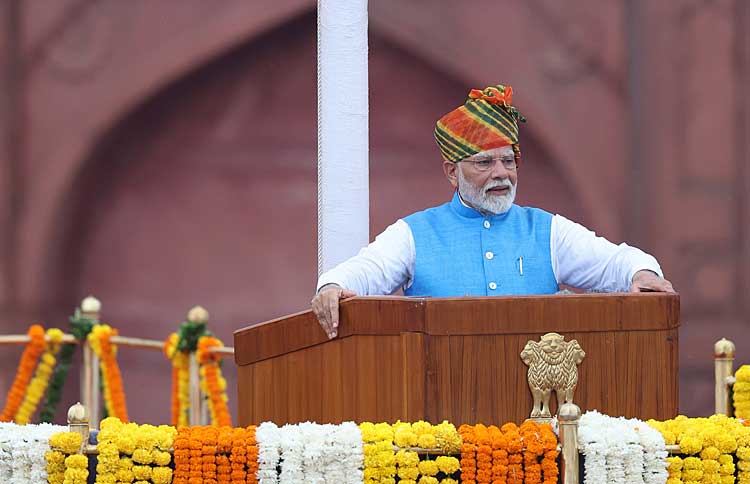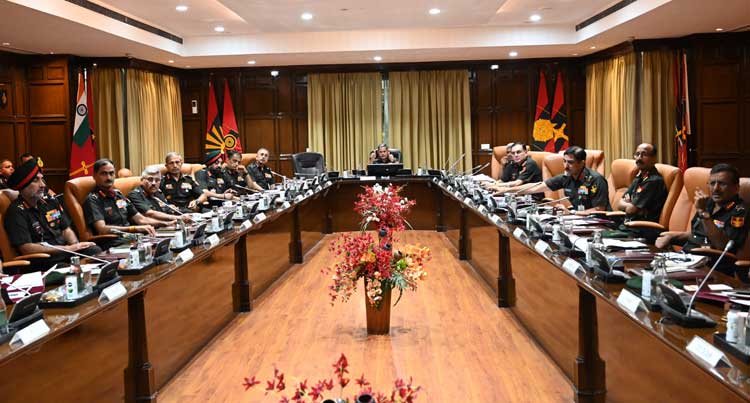INDIAN ARMED FORCES CHIEFS ON OUR RELENTLESS AND FOCUSED PUBLISHING EFFORTS

The insightful articles, inspiring narrations and analytical perspectives presented by the Editorial Team, establish an alluring connect with the reader. My compliments and best wishes to SP Guide Publications.

"Over the past 60 years, the growth of SP Guide Publications has mirrored the rising stature of Indian Navy. Its well-researched and informative magazines on Defence and Aerospace sector have served to shape an educated opinion of our military personnel, policy makers and the public alike. I wish SP's Publication team continued success, fair winds and following seas in all future endeavour!"

Since, its inception in 1964, SP Guide Publications has consistently demonstrated commitment to high-quality journalism in the aerospace and defence sectors, earning a well-deserved reputation as Asia's largest media house in this domain. I wish SP Guide Publications continued success in its pursuit of excellence.
- Operation Sindoor: Resolute yet Restrained
- India’s Operation Sindoor Sends a Clear Message to Terror and the World – ‘ZERO TOLERANCE’
- Japan and India set forth a defence cooperation consultancy framework, talks on tank and jet engines
- Terrorist Attack in Pahalgam in Kashmir: Unfolding a long surgical war against PAK
- Lt General Pratik Sharma takes over Command of Indian Army's Northern Command
Indian Army's Future Goals
The Indian Army's Vision@2047 is “to transform into a modern, agile, adaptive, technology-enabled, and self-reliant future-ready force, capable of deterring and winning wars in a multi-domain environment”
 |
The Author is Former Director General of Information Systems and A Special Forces Veteran, Indian Army |

Addressing the nation from the ramparts of the Red Fort on August 15, 2024 on the occasion of the 78th Independence Day, Prime Minister Narendra Modi spoke the theme of "Viksit Bharat @ 2047", which is expected to serve as a platform to provide a renewed push to the government's efforts towards transforming the country into a developed nation by 2047 – the centenary of India's independence.
The "Viksit Bharat @ 2047" campaign aims to address various socio-economic challenges through a holistic approach, focusing on infrastructure, education, healthcare, technology, and sustainable development. In his August 15 address, Prime Minister Modi had mentioned the strides made by India to further self-reliance in the critical defence manufacturing sector and how the country had gradually transformed itself from being an importer of military hardware to an exporter. Earlier on July 2, Modi had said in Parliament that the creation of theatre commands to bolster national security is on track, modernisation of the Armed Forces is in full swing, and the government is working on reforms to ensure the military was always battle ready.
Prime Minister Narendra Modi's "Viksit Bharat @ 2047" campaign aims to transform India into a developed nation by the centenary of its independence, focusing on infrastructure, education, healthcare, technology, and sustainable development.

Following on the above, General Upendra Dwivedi, the Chief of the Army Staff (COAS) chaired a two-day discussion commencing August 19, 2024, to outline the Amy's strategy and priorities during the Amrit Kaal (the period leading to India's independence centenary) and align the Army's goals with the government's vision of making India a developed country and a significant global player by 2047. The meeting was attended by the General Officer Commanding-in-Chiefs (GOC-in-Cs) of the Indian Army's seven commands. A statement issued by the Army said, "The forum provided an opportunity for the Indian Army's top brass to brainstorm on strategic issues and set the direction for the army's transformation over the next two decades."
The discussions were centred around the ongoing transformational initiatives by the Indian Army and its contribution towards achieving the objective of Viksit Bharat@2047. The senior leadership engaged in interactive discussions to define the Army's role in the national vision and articulated the Indian Army's Vision@2047: "To transform into a modern, agile, adaptive, technology-enabled, and self-reliant future-ready force, capable of deterring and winning wars in a multi-domain environment across the spectrum of operations, to protect our national interests in synergy with the other Services."
Key goals outlined for the Indian Army's transformation include Theaterisation, modernisation of combat arms, integration of joint operations with the Navy and Air Force, and promoting self-reliance in defence manufacturing
Several broad goals were outlined to be pursued over the next decade, including: Theaterisation, reorganisation of Army and Command Headquarters, realignment of Command, Corps and Area HQ boundaries. Other discussion agendas included World Class Infrastructure Development, enhancing Multi-Domain and Cross-Domain Operational Capabilities to include land, air, cyber and space. Conduct of Data-Centric Operations by leveraging technology was also deliberated upon to enhance the existing capabilities.
Roadmap for capability development for upgrading of Mechanised Forces, Artillery, Army Aviation, Air Defence and Infantry was also discussed together with options for enhancement of logistics, ammunition infrastructure, requirement of new structures to support multi domain operations and framework for expediting automation and networking of systems, processes and functions were discussed.

Actions to enhance jointness and integration in the Armed Forces were also discussed for strengthening of joint service structures and organisations besides the need to establish common military stations and units for logistics, communication, and other essential services. Human Resource Development initiatives aimed at improving the quality and effectiveness of personnel across the ranks were also deliberated upon.
General Dwivedi exhorted all stakeholders to promote Atmanirbharta, strive to achieve self-reliance in Indigenisation of equipment, platforms, and weapons, support Indian Defence Industries in not only developing world-class equipment but also facilitate in becoming a leading defence exporter.
General Dwivedi called for promoting Atmanirbharta (self-reliance) in the indigenisation of equipment and weapons, supporting Indian defence industries, and making India a leading defence exporter.
Key focus areas of the proposed goals and initiatives of the Indian Army included: reorganisation of Army Headquarters, Command Headquarters, and other key formations to ensure optimal efficiency and operational readiness; modernisation of all the combat arms, combat support arms and the logistics units; enhancing joint operations and integration between the Army, Navy and Air Force to face the future challenges of warfare, commitment towards indigenisation, supporting the domestic defence industry and facilitating India's position as a leading defence exporter.
The discussions concluded with the ongoing initiatives of Indian Army aligned to the National Vision to include
- Leadership in military education was highlighted, with the Centre for UN Peacekeeping (CUNPK) recognised as a Center of excellence;
- Defence diplomacy through increased number of defence wings in missions abroad, the Army's role in UN missions and participation in joint exercises with foreign countries;
- The Army's involvement in national initiatives like 'Gati Shakti' was discussed, with progress made in identifying and developing dual-use infrastructure;
- Indian Army's contributions to healthcare through the ECHS and military hospitals, as well as its role in education and skill development through initiatives like the 'Kaushalveer' scheme;
- The Army's efforts in empowering the youth through the National Cadet Corps (NCC) and promoting sports through 'Mission Olympic' for providing world class training to the potential medal winners in Olympics.
The discussions reaffirmed the Indian Army's commitment to evolving into a future-ready force that is not only capable of protecting national interests but also contributing significantly to the vision of Viksit Bharat@2047.
Concerns are raised about the Indian Army's modernisation pace, especially in comparison to China, and the inadequacy of the 1.9 per cent of GDP defence budget in addressing the multi-front threats India faces
Finally, it may be said that the Indian Army has always delivered. Its future planning aligned with the vision of Viksit Bharat@2047 would also be systemic and elaborate. But modernisation of the Indian Army is far from satisfactory, especially when compared to China and the multi-front threat that we face, and the annual budgetary allocation of 1.9 per cent of GDP for defence is grossly inadequate.
A veteran Vice Chief of Army Staff writes, "we have a serious handicap. Despite the tomtomimg of India becoming the fourth largest economy, our per capita Income compares poorly with that of Bangladesh and Pakistan. We have serious handicaps. Besides, the imports from China have grown since Galwan in 2020. Do we have it in us to rough it out and tighten our belts? Our Leaders are looking at just the next elections and no one is willing to recommend guns over butter. We in uniform may crib about it but I don't see light at the end of the tunnel. We may barter some more land to look good and continue the freebies to the teeming masses." Moreover, absence of a national security strategy amounts to shadow-boxing and ad hoc advancements, and we are in an environment where the military is kept out of strategic security formulations. Unless these issues are seriously addressed, we will not be able to arrive at the right mix of economy and security.





